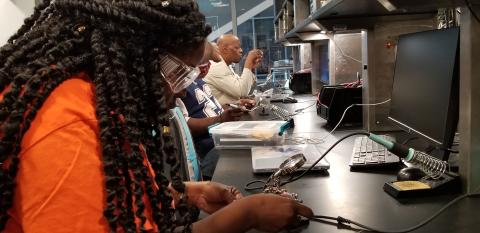Body
Image

Equity Strategies of the Head, Heart, and Hands: A Networked Improvement Community Approach to Designing for More Inclusive Informal STEM Learning Environments
The CISTEME365 initiative is in its 6th year of implementation, and despite contextual changes that occurred over the years, this project has remained true to its three pillars of engagement: (1) building a professional learning network for school-based teams made up of counselors, teachers, and other relevant school stakeholders with professional development aimed at providing more equitable and inclusive STEM environments, (2) supporting the implementation of STEM-enrichment clubs at each school site, and (3) offering fully-covered scholarships for STEM club student participants to attend STEM-immersive summer camps at the University of Illinois.
Pillar 1: Innovative Use of Technologies in Learning and Teaching
School-based teams of teachers and counselors (IDEA Teams) engage in year-round professional learning that begins with a summer institute focused on project-based learning in electrical engineering and strategies for creating equitable and inclusive STEM environments. IDEA Teams put learning into action by forming STEM clubs in their home schools and engaging in Action Research for Equity Projects. Monthly Networked Improvement Community sessions via Zoom allow teams to share progress and to troubleshoot challenges.
Pillar 2: Partnerships for Career and Workforce Preparation.
CISTEME365 is a partnership between The University of Illinois’ Grainger College of Engineering, the National Alliance for Partnerships in Equity, and participating schools. A focus on out-of-school time for STEM learning increases the competitiveness of engaged students when compared to their peers from high-resource, high-access communities. Introducing students to a range of career opportunities and to engineers from diverse backgrounds, the students are able to better envision themselves in future STEM careers.
Pillar 3: Strategies for Equity in STEM Education
By uniquely embedding equity and inclusion strategies with training in STEM technical concepts, educators are better able to see the relationship between these two, often siloed topics. The Action Research for Equity Project provides a tool that can be used well into the future for assessing efforts to increase equity and inclusion in STEM. A key product resulting from the CISTEME365 initiative is the Head, Heart, & Hands rubric for Designing Inclusive STEM Learning Environments.

Discipline(s)
Engineering
Target Gradespan(s)
Middle school (6-8)
High school (9-12)
Target Participant(s)
Educators
Parents / caregivers / families
Girls (or women)
American Indian/Alaska Native participants
Black/African American participants
Hispanic/Latino participants
Project Setting(s)
Informal Education
Category
Strategies